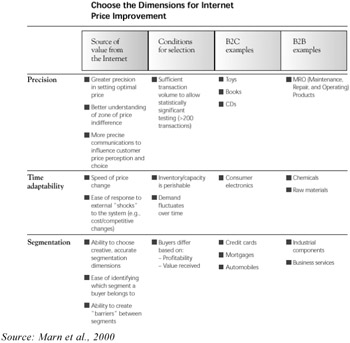Implications for Theory and Practice
|
From a strategic perspective, the implications for theory and practice are significant. To help shed some light on these implications, Table 1 evaluates the advantages and disadvantages of various online pricing techniques by looking at the benefits and threats to vendors and consumers.
| Benefits to vendor | Threats to vendor | Benefits to consumers | Threats to consumer benefits | |
|---|---|---|---|---|
| Fixed price | Easy to manage | May be irrelevant for demand | Not confusing/take it or leave it | May not get a bargain price |
| Set price through auction | Liquidate excess inventory Let market decide price for special goods (e.g., antiques) | May not be very efficient for quick or large sales Uncertainty of number of bidders and their reservation prices | Exciting May get a bargain | May be time consuming May not worth it for inexpensive items |
| Personalized pricing | Match price for what each individual customer is willing to pay and unique situation | Has to accurately measure each consumer's utility function for the product Consumers may resent being treated differently from others | Only pay what the customer think is worthwhile Price is relevant for personal situation | Some may not get good prices May feel get "ripped off" at times |
| Yield Management pricing | Match price and available capacity Maximize profits | Large investments in technology and information systems Consumers may resent being treated differently from others | Price sensitive consumers may enjoy similar service at lower prices | Some may feel get "ripped off" at times |
| Name your price | Flexibility in price setting | Has to carefully calculate how many "offered prices" the company should accept | May get good deals | Many restrictions on receiving the offer |
| Consumer group buying | Can sell to a large group of buyers at one time | Uncertainty about the formation of consumer groups | Get good deals through group buying power | Has to wait until a group of buyers who share the same buying interest are ready |
Research shows that there are three ways in which marketers can profit from the flexibility of e-pricing (Marn et al., 2000; Marn & Rosiello, 1992):
-
Precision in price levels and price communication. The payoff is enormous for companies that can identify the range of possible prices within which customers are indifferent to increases or decreases.
-
Time adaptiveness in response to market changes. Online pricing is adaptable, and allows companies to make swift adjustments in response to market conditions.
-
Segmentation of prices. Online companies can use multiple sources of customer information to determine a customer's appropriate segment and set prices accordingly.
In order to execute an online pricing strategy that takes advantage of these opportunities, marketers must (Marn et al., 2000):
-
Identify degrees of freedom consistent with strategy and brand. Choose e-pricing approaches that do not conflict with key strategic objectives, core business principles, or brand promise. For example, lowering prices online for a product that is being positioned as a higher benefit, higher priced product might increase the near-term volume of sales, but it could hurt the brand image in the long-term. On the other hand, an airline might offer lower fares online since customers understand that the airlines can pass on the savings from the travel agent commissions to the customers.
-
Build appropriate technological capabilities. Pursuing e-pricing opportunities does not necessarily require huge systems investments. The key is to use limited tests of alternative price levels, structures and price communication to see what level of granularity along the three dimensions is worth pursuing.
-
Build an experimenting and nimble pricing organization. Online realities require constant tests to find opportunities and also require an empowered and responsive pricing organization.

Figure 2: Dimensions for Internet Price Improvement.
|
EAN: 2147483647
Pages: 195